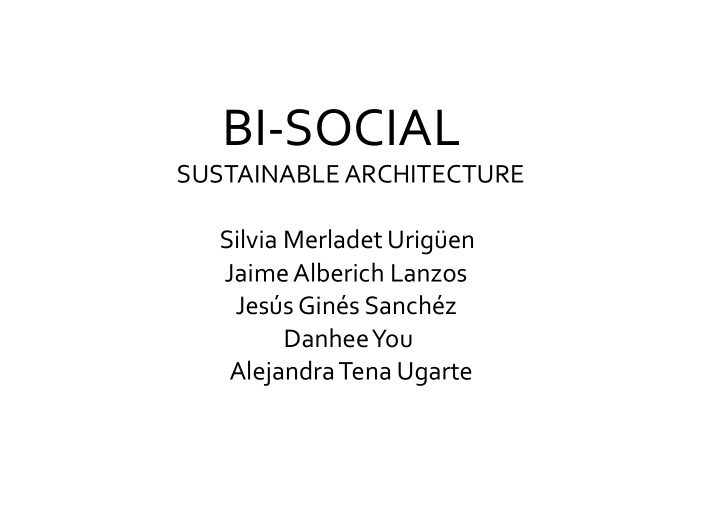



¡ ¡ ¡ ¡ ¡ ¡ ¡ ¡ ¡ ¡ ¡ ¡ ¡ ¡ ¡ ¡ ¡ ¡ BI-‑SOCIAL ¡ ¡ ¡ ¡ ¡ ¡ ¡ ¡ ¡ ¡ ¡ ¡ ¡ ¡ ¡ ¡ ¡ ¡ ¡SUSTAINABLE ¡ARCHITECTURE ¡ ¡ ¡ ¡ ¡ ¡ ¡ ¡ ¡ ¡ ¡ ¡ ¡ ¡ ¡ ¡ ¡ ¡ ¡ ¡ ¡ ¡ ¡ ¡ ¡ ¡ ¡Silvia ¡Merladet ¡Urigüen ¡ ¡ ¡ ¡ ¡ ¡ ¡ ¡ ¡ ¡ ¡ ¡ ¡ ¡ ¡ ¡ ¡ ¡ ¡ ¡ ¡ ¡ ¡ ¡ ¡ ¡ ¡ ¡Jaime ¡Alberich ¡Lanzos ¡ ¡ ¡ ¡ ¡ ¡ ¡ ¡ ¡ ¡ ¡ ¡ ¡ ¡ ¡ ¡ ¡ ¡ ¡ ¡ ¡ ¡ ¡ ¡ ¡ ¡ ¡ ¡ ¡ ¡Jesús ¡Ginés ¡Sanchéz ¡ ¡ ¡ ¡ ¡ ¡ ¡ ¡ ¡ ¡ ¡ ¡ ¡ ¡ ¡ ¡ ¡ ¡ ¡ ¡ ¡ ¡ ¡ ¡ ¡ ¡ ¡ ¡ ¡ ¡ ¡ ¡ ¡ ¡ ¡ ¡ ¡ ¡ ¡Danhee ¡You ¡ ¡ ¡ ¡ ¡ ¡ ¡ ¡ ¡ ¡ ¡ ¡ ¡ ¡ ¡ ¡ ¡ ¡ ¡ ¡ ¡ ¡ ¡ ¡ ¡ ¡ ¡ ¡ ¡Alejandra ¡Tena ¡Ugarte ¡
UTOPIA ¡
Sustainable ¡Building ¡Materials ¡
Criteria ¡of ¡selec-ng ¡green ¡materials ¡
Pre-‑Building ¡phase ¡ -‑Waste ¡Reduc5on ¡ • -‑Pollu5on ¡Preven5on ¡ • -‑Recycled ¡Content ¡ • -‑Embodied ¡Energy ¡reduc5on ¡ • -‑Use ¡of ¡natural ¡materials ¡ •
Building ¡phase ¡ -‑Reduc5on ¡in ¡construc5on ¡waste ¡ • -‑Energy ¡Efficiency ¡ • -‑Water ¡treatment/conserva5on ¡ • -‑Use ¡of ¡non-‑toxic ¡or ¡less ¡toxic ¡materials ¡ • -‑Renewable ¡Energy ¡Systems ¡ • -‑Longer ¡life ¡ •
Post ¡building ¡phase ¡ -‑Reusability ¡ • -‑Recyclability ¡ • -‑Biodegradability ¡ •
Wool ¡brick ¡
Sustainable ¡Concrete ¡
Solar ¡Tiles ¡
Paper ¡insula5on ¡
Triple-‑glazed ¡windows ¡
Bamboo ¡
Waste Management Only what we can not reuse or recycle is waste that must be managed. (DETR Berret Building a Quality of life- A Strategy for more Sustanaible Construction, 2000)
-Minimize waste in the design phase. ¡ -Minimize waste in the construction phase.
How can we minimize waste in the design phase? Choose low-waste materials. ¡ 1. Designing facade, floors, according to their maximum advantage. ¡ 2. Design construction details that reduce working on site. ¡ 3. Choosing materials avoiding the ones that contain harmful substances. ¡ 4. 5. Avoid using glued layers, because they are very difficult to recycle.
How can we minimize waste in the construction phase? Appoint a manager to be responsible of the management of waste on site. ¡ 1. Develop a waste management plan tailored to the plot. ¡ 2. Communication with the staff of the building site. ¡ 3. 4. Improving access to orders and to allow the "just in time", a service that can bring the material when to use. ¡ Store and handle with care. ¡ 5. Keep materials packaged until it’s use. ¡ 6. 7. Perform demolitions so that you can reuse as much and separate waste for reuse and recycling. ¡ 8. Separating the toxic waste to avoid mixing with other products..
MORE ¡POPULAR ¡
MINIMIZES IMPACT OF BUILDING IN THE ENVIRONMENT
Answers the principles of SUSTAINABILITY: ECONOMI C SOCIAL AND ECOLOGICAL
Protecting the environment
CONSUMES NATURAL RESOURCES energy, water, woods USES RENEWABLE RESOURCES sunlight, plants, rainwater, recycled materials
POSITIVE ¡ASPECTS ¡ • COST • ENERGY EFFICIENCY • WATER EFFICIENCY • MATERIAL EFFICIENCY
Cost ¡ Higher beacause of special requirements Saves energy, money spent will return
Energy ¡efficiency ¡ wind power, hydro power extra-insulation, high performance windows, passive solar design Wood buildings Brick or Steel buildings
Water ¡efficiency ¡ Wasted water Recycling rainwater
Material efficiency Renewable, non-toxic, recycable straw lumber Compressed earth bamboo
NEGATIVE ¡ASPECTS ¡ • COST • LOCATION • AVAILABILITY OF MATERIALS • TIME • GREEN ROOFS
sustainability = Solar paneling length of service Infrastructure has to support it and effectiveness
Location Natural light Circunstance s of the area
Availability of Materials
Time ¡
Green ¡Roofs ¡
promote this ADVANCED natural resources are dropping ARCHITECTURE to our o ff and because of the SOCIETY awareness of people
Recommend
More recommend